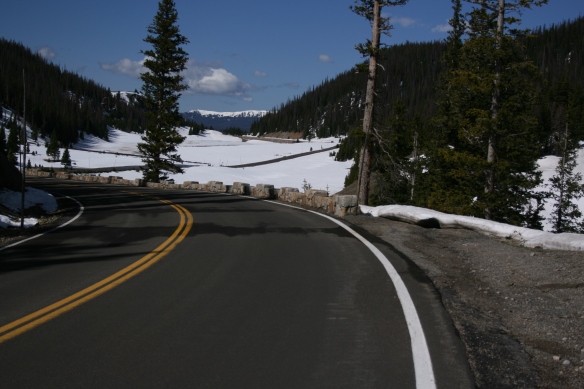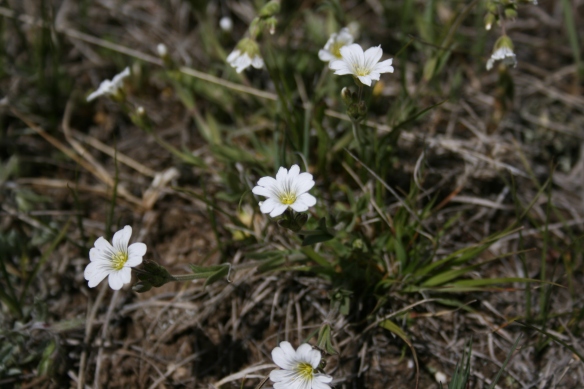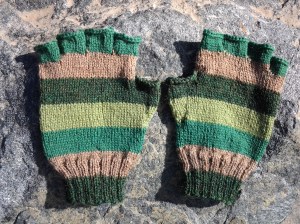I got a late start today, by hiking standards. In the summer, I generally start my longer hikes around 7 a.m. Today, I hit the trailhead about Noon. I didn’t have the longest trek planned, so a late start was fine. I relaxed this morning, ate a good breakfast and worked on a project until I was well-caffeinated and ready to go.
Bear Lake was fairly busy, but I took the first left turn and headed up to Nymph and Dream Lakes. How many times have I taken this trail? I’ve covered that 1.1 miles in the fresh green of spring, the heat of summer, golden Aspen leaves of autumn, and the blowing snow of winter. Like so many times before, I found myself seeing a few other hikers over and over as we made our way up the hill. Many were on their first visit to Rocky, college students from several states and retirees from Alabama.
You see, this is part of the beauty of the National Parks – they are a great melting pot. People from all over the world, challenging themselves physically and mentally. Learning about history and famous people, teaching themselves to conquer fears and reconnect with the resources that sustain their lives. So often, the National Parks force people to the same level – novices against Mother Nature.
Perhaps I should have challenged myself a bit more. I’ve done the snowshoe to Dream Lake maybe 15-20 times, and I sort of have every curve of the trail memorized. But I needed fresh air and I got a late start. So any miles were better than no miles. Dream Lake never disappoints. (By the way, the trail I did was about 1.1 miles and 450 feet of elevation gain, according to trail guides, although I did a bit of off-trail up at the lake just to get a different view.)
There is one section of the trail, about halfway between Nymph and Dream Lakes, where the winter trail is very narrow on the best of days and on warm sunny days like today, the snow is slippery and the trail deteriorates a little bit with every new set of footsteps. Add to this that the trail often is as wide as only one snowshoe. Going uphill might seem hard to some, but in my experience, downhill is much more nerve-wrecking. Gravity on a downhill slide is far more of an enemy.

Looking up the scary, narrow section. It’s steeper than the picture portrays.
After my lovely snack up at the lake, I decided it was time to head down the hill. I made it back down to the scary section, and there were people slipping and falling trying to get up the hill. Since I had snowshoes with crampons, I just waited at the top for a clear trail. A few other hikers lined up behind me, waiting as well. I chatted with them as we waited for the uphill folks to finish. One guy, maybe in his late 20s, looked longingly at my snowshoes. He said he’d not been too afraid going up, but watching folks now, he was a bit freaked. I told him I felt the same, even with my crampons. I pointed to the narrowest section and suggested that it would be fine if someone would just kick in an extra step. I showed him where to put his feet, all the while, telling myself that I could do the same. I could get past the scary bit. With my crazy big snowshoes, it might be really tight, but I’d done it before and I will live to do it again.
Perhaps now is a good time to share a lesson I’ve learned over the years: when on slippery, downhill trails, if I have snowshoes, I let everyone else in boots go ahead of me, even if I can move faster than them (which is usually the case since I have good traction). That way, when they slip and fall, they don’t slide into me and take me down with them. I won’t say how or when I learned this lesson. 😉
Anyway, the guy said he’d try to kick in an extra step. His group headed down ahead of me, and all four of their group slipped and fell a bit. But they managed to kick in an extra step with only one scream uttered between them. He looked back up at me and said something about wanting to go back uphill. Other folks came around the bend, making their way up the hill at that moment and there was a time of crowding, confusion and nerves. I stepped to the side (thank goodness for those snowshoes) and let the uphill folks plow on. I was very thankful that the guys kicked the trail wider; it calmed my nerves quite a bit.
By letting groups pass me, I had a peaceful snowshoe down the trail. Back at Bear Lake, I decided to walk up to that lake – maybe only 200 feet further than my trail junction. It was very slick due to the high volume of traffic all winter, and melting and refreezing of snow. Several older folks told me I was smart to wear snowshoes. I smiled and said I’d just finished a bigger hike where I needed the traction.
One such older woman was clearly very scared of slipping and falling. Complete with a thick southern accent, perfectly dyed hair and makeup to make her look younger than she was, thin black jogging shoes and lots of chunky jewelry, she looked rather out of place. She had two men with her – I’m guessing her husband and her son. She was moving very slowly away from Bear Lake, back through the woods towards the parking lot. I asked if she wanted to borrow one of my hiking poles so that she had two to use. She turned me down. Her husband just smiled.
So I moved on to Bear Lake, and enjoyed watching people having snowball fights and building snowmen out on the frozen lake. Eventually, I turned around and started heading back to my car.
The older woman hadn’t made it more than 4-5 feet since I’d passed her going up to the lake. This time, she had two more people around her – a couple maybe in their 30s. I waited in the line of traffic on the trail for a minute and then made a decision. I had traction, whereas no one else in the vicinity did. Everyone was moving very slowly and there was a bottleneck on the trail.

Looks pretty tame from this perspective, but the icy trail scared older folks who had no traction. Bear Lake is the clearing just beyond the trees.
I picked up my pace, side-stepped around the crowd and stopped just in front of them. “This is what we’re going to do,” I said. “Let me help you.” I stomped pretty hard on the packed snow and ice in front of the woman. I assured her that I wasn’t going to slide, and showed her the crampons built into the decks of my snowshoes. I also pointed out that I was more… stout than she. She looked up and tried to laugh, but behind her sunglasses, I’m pretty sure she was in tears.
I offered my hand, which she took with her free hand. Someone had managed to give her a hiking pole which I reminded her to keep in contact with the ground when she lifted a foot to take a step. (In her case, two points of contact with the ground were better than one.) Her husband held tightly to her upper arm, and I snowshoed backwards, breaking up the ice, as we brought her down the hill. She held tightly to my hand the whole time. I was thankful that she seemed to catch on quickly to the idea of stepping where I’d broken the trail; wet feet were better than sliding and falling.
People watched us, and I’m sure the effort was a sight. The woman was rather vocal, in her southern accent, about how she couldn’t have done the walk back without me. (Well, she could have, but it would have taken a lot longer.)
This is what rangers do. We help people from all over live to tell stories of their adventures in the parks. Just another day in the park.
















